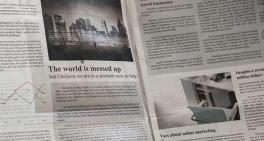SUPREME COURT NOTEBOOK: Diabetes, decisions and justice math
National Court News
Visitors attending Supreme Court arguments surrender their electronics on entering the courtroom. So if something rings, chimes or buzzes, it's likely the device's owner is dressed in a black robe.
Last year, a justice's cellphone went off. But last month, when four electronic pings sounded during an argument, the device was different. It belonged to Justice Sonia Sotomayor and was alerting the justice, who is diabetic, that her blood sugar was urgently low.
The 63-year-old justice has had diabetes since childhood, but the sound was the first public notice that she was using a continuous glucose monitor.
Sotomayor's use of the device doesn't indicate a change in her health, experts told The Associated Press, but it does show her embracing a technology that has become more popular with Type 1 diabetics.
In 2013, when Sotomayor did an interview with the American Diabetes Association's "Diabetes Forecast," the magazine reported she was not using one. But in recent years the devices, which use sensors inserted under the skin, have become more accurate, said Cleveland Clinic endocrinologist Kevin Pantalone.
Monitors give users continuous information about glucose levels, rather than the snapshot they get from testing their blood with a finger prick. Information from the sensor gets sent every few minutes to a device where a user can see it charted. Most devices sound alarms at low and high glucose levels. Some monitors work with an insulin pump, which continuously delivers insulin.
It's not clear when Sotomayor began using the technology. She declined comment through a court spokeswoman. But the dinging during arguments on March 21 followed an incident in January where emergency medical personnel treated her at home for symptoms of low blood sugar.
Aaron Kowalski, an expert in diabetes technologies, said an event like that can prompt a person to try a monitor, but even people using the devices can experience low blood sugar that might result in an emergency call. Kowalski, who leads the research and advocacy efforts of JDRF, the Type 1 diabetes research organization, said about 15 percent to 20 percent of Type 1 diabetics now use such a device.
Related listings
-
NY high court nixes Trump's bid to delay defamation suit
National Court News 06/15/2018New York's highest court on Thursday turned down President Donald Trump's latest bid to delay a defamation suit filed by a former "Apprentice" contestant who accused him of unwanted groping and kissing.The ruling by the state Court of Appeals didn't ...
-
Supreme Court strikes down Minnesota's voter clothing law
National Court News 06/12/2018The Supreme Court on Thursday struck down a Minnesota law that barred voters in the state from wearing a wide range of political hats, T-shirts and pins to the polls.Minnesota had defended its law as a reasonable restriction that keeps order at polli...
-
Supreme Court: Son can sue father over hunting accident
National Court News 06/06/2018A Minnesota man has taken a lawsuit against his father all the way to the Minnesota Supreme Court. And, dad is just fine with that.The Supreme Court this week clarified a state law on public access for hunting, clearing the way for Corey Ouradnik to ...

USCIS Adjusting Premium Processing Fee
U.S. Citizenship and Immigration Services (USCIS) announced today it is adjusting the premium processing fee for Form I-129, Petition for a Nonimmigrant Worker and Form I-140, Immigrant Petition for Alien Workers beginning on Oct. 1, 2018 to more effectively adjudicate petitions and maintain effective service to petitioners.
The premium processing fee will increase to $1,410, a 14.92 percent increase (after rounding) from the current fee of $1,225. This increase, which is done in accordance with the Immigration and Nationality Act, represents the percentage change in inflation since the fee was last increased in 2010 based on the Consumer Price Index for all Urban Consumers.
“Because premium processing fees have not been adjusted since 2010, our ability to improve the adjudications and service processes for all petitioners has been hindered as we’ve experienced significantly higher demand for immigration benefits. Ultimately, adjusting the premium processing fee will allow us to continue making necessary investments in staff and technology to administer various immigration benefit requests more effectively and efficiently,” said Chief Financial Officer Joseph Moore. “USCIS will continue adjudicating all petitions on a case-by-case basis to determine if they meet all standards required under applicable law, policies, and regulations.”
Premium processing is an optional service that is currently authorized for certain petitioners filing Forms I-129 or I-140. The system allows petitioners to request 15-day processing of certain employment-based immigration benefit requests if they pay an extra fee. The premium processing fee is paid in addition to the base filing fee and any other applicable fees, which cannot be waived.




